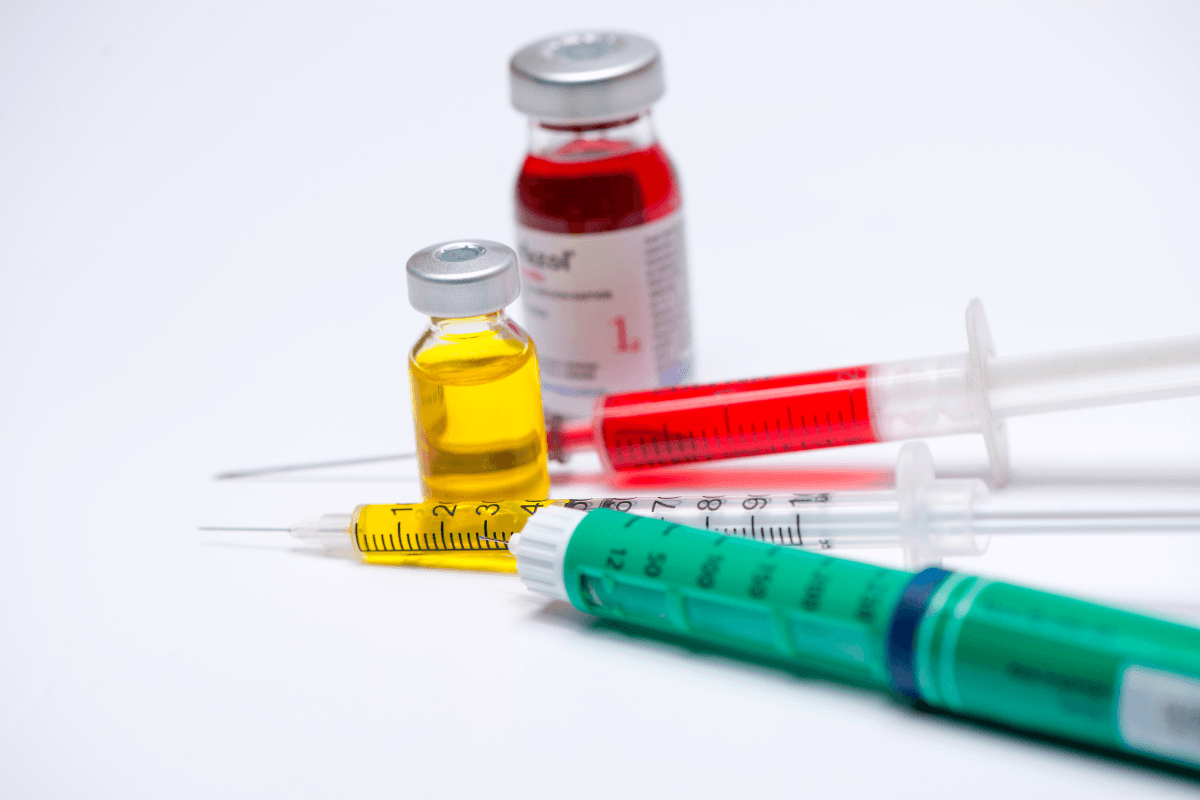Choosing between an insulin pen and a syringe affects accuracy, routine, and confidence. Most people compare insulin pen vs syringe when they start insulin, change insulins, or travel more. The “best” option is usually the one you can use correctly every time. Your insulin type, vision, hand strength, and budget all matter.
This guide explains how pens and syringes work, where errors happen, and what to ask your clinician or pharmacist. It uses both clinical terms and plain-language steps. It does not replace the instructions for use that come with your device.
Key Takeaways
- Pens dial a dose; syringes draw it from a vial.
- Unit markings and concentration must match (often U-100).
- Needle fit and technique affect comfort and accuracy.
- Priming a pen helps reduce air and mis-dosing.
- Cost and waste differ; your routine matters most.
CanadianInsulin works as a prescription referral service for diabetes medications.
Insulin Pen vs Syringe: How They Differ Day to Day
Both tools deliver insulin into subcutaneous tissue (the fat layer under skin). The difference is how you measure the dose. With a pen, you attach a pen needle, “dial” a number, and press an injection button. With a syringe, you insert the needle into a vial and draw up insulin to a line on the barrel.
Daily handling is where many people notice the biggest contrast. Pens tend to be quicker to set up and easier to carry. Syringes tend to be simpler mechanically and work with most vials, but they require steady measuring and good lighting. Either method can be safe and effective when used as directed.
| Practical factor | Insulin pen | Vial and syringe |
|---|---|---|
| Dose measuring | Dials units; click-based increments | Draws to a marked line |
| Portability | Often easier to carry discreetly | Requires vial + syringe + supplies |
| Dexterity needs | Button force and grip matter | Fine motor control to draw accurately |
| Flexibility | Depends on pen/cartridge availability | Works with compatible vials |
| Waste and disposal | More plastic components | More sharps, fewer pen bodies |
For background on delivery options, see Ways Of Administering Insulin.
Understanding Pen Types: Disposable and Reusable
There are two broad pen formats. A disposable insulin pen comes prefilled and is discarded when empty. A reusable insulin pen (sometimes called a refillable injection pen) is kept and loaded with a refillable insulin pen cartridge. The pen needle is replaced each time. In real life, the choice often depends on which insulin you use and what your pharmacy can supply reliably.
Many people use pens for both insulin pens for type 1 diabetes and insulin pens for type 2 diabetes. The underlying need is the same: consistent dosing and a routine you can repeat. When someone says “best insulin pen for type 2 diabetes,” what they usually mean is “a pen that matches my insulin, my hands, and my daily schedule.” Your prescriber and pharmacist help align those pieces.
Disposable pen vs refillable pen bodies
Disposable pens reduce steps because the insulin is already inside the device. Reusable pen bodies reduce waste but add steps because you load and replace cartridges. Cartridge-based systems can also be useful when you want a stable, familiar pen body and only change the insulin reservoir. To understand how cartridges work and what changes between systems, read Insulin Cartridges.
In an insulin pen vs syringe decision, also consider your environment. If you often dose away from home, a pen can feel more manageable. If you already store and use vials, a syringe may fit better. Neither approach is “more serious” or “less serious.” It is a tool choice.
If needed, prescriptions are confirmed with your prescriber before processing.
Example: A person with reduced hand strength finds it hard to pull a plunger smoothly. They may prefer a pen, because dialing can feel steadier. Another person who uses mixed doses and is comfortable measuring may prefer vials and syringes, because they can see the liquid and markings clearly.
On CanadianInsulin, you can also browse insulin-related items in the Diabetes Products category, including pen-compatible options such as Novolin GE Penfill Cartridges and prefilled devices like Lantus SoloStar Pens.
Needles, Syringes, and Units: Avoiding Measurement Errors
Most day-to-day errors are measurement errors. That can mean dialing the wrong number, drawing to the wrong line, or using the wrong syringe for the insulin concentration. Many people in the U.S. and Canada use U-100 insulin, meaning 100 units per mL. A common syringe type is a U 100 insulin syringe 1ml, which matches that concentration. If you use a different concentration insulin, the syringe type must match the label directions.
Why it matters: Unit mismatches can lead to large dosing errors.
Another difference is how the unit display relates to liquid volume. Insulin pen vs syringe units can feel confusing at first because pens show a number you dial, while syringes show lines you fill to. They both represent “units,” but the way you confirm the dose is different. If you ever feel unsure, pause and compare your insulin label, syringe packaging, and training instructions.
Pen needle sizing and comfort
Insulin pen needles sizes are described by length (mm) and gauge (G). Gauge refers to thickness; a higher gauge is thinner. Many people ask about insulin pen needles 32g 4mm because it is a commonly discussed size. A shorter needle may reduce the chance of injecting into muscle for some body types, but technique still matters. Your clinician may suggest a size based on your build, injection sites, and comfort.
People also ask, are insulin pen needles universal. Many pen needles use similar connections, but “universal” is not guaranteed across every pen. Packaging usually lists compatible pen brands. When you change pen brands or switch from disposable to cartridge systems, confirm compatibility before assuming a needle fits.
For detailed visuals, see Insulin Pen Needles Guide and Insulin Syringes Measurements. If you use syringes, examples include BD Ultra-Fine II Syringes.
Technique Basics: Priming, Injection Sites, and Disposal
Good technique is repetitive and boring. That is the point. With pens, priming is one of the steps people skip. Priming means expelling a small amount of insulin to clear air and confirm flow. What happens if you don t prime insulin pen depends on the device and situation, but the practical risk is that you may deliver less insulin than you think, especially if air is present or a needle is blocked.
Quick tip: Follow your pen’s priming steps every time you attach a new needle.
Injection site choice also matters. Repeated injections in the same spot can contribute to lipohypertrophy (fatty lumps under the skin), which can change absorption. Rotating sites is a simple habit that protects your skin over time. For site basics, see Best Insulin Injection Sites.
Disposal is part of technique, not an afterthought. Used pen needles and syringes are sharps. They should go into an appropriate sharps container and follow local disposal rules. A practical overview is in Sharps Insulin Disposal.
Cost, Waste, and Travel Practicalities
People often compare insulin pen vs syringe cost, but the answer is rarely simple. Total expense depends on your insulin type, insurance coverage, pharmacy pricing, and how many supplies you use. Pens can have higher device-related costs, while vials and syringes can be less expensive per unit for some people. But cost can shift if a pen reduces wasted doses or missed injections due to convenience.
Also consider “soft costs.” That includes time, storage, and stress. Pens can reduce the number of separate items you carry, which may help with workdays and public dosing. Syringes may be easier to visually confirm if you prefer to see the liquid volume. If you travel often, plan for needle disposal and backup supplies in both cases.
Access considerations without overpromising
Some people use cross-border options when paying cash, including those without insurance. CanadianInsulin may support Ships from Canada to US for eligible prescriptions through partner channels. The goal is continuity, not shortcuts. Bring your prescription details, and keep a backup plan for supply gaps.
Medications are dispensed by licensed Canadian pharmacies for cash-pay access, often without insurance.
If you want to browse broader support topics, the Diabetes Articles hub and the Diabetes Condition Hub are useful starting points.
Common Mistakes That Lead to Wrong Doses
Most problems are not “mysteries.” They are small procedural slips that stack up. The difference between insulin syringe and insulin pen is not only the hardware. It is also where your attention goes. Syringes demand careful measurement and air-bubble control. Pens demand priming, needle changes, and correct dialing.
These are common pitfalls to watch for. They are also good discussion points for training refreshers.
- Skipping priming steps + blocked needle risk
- Reusing needles + more pain, leakage
- Wrong syringe type + concentration mismatch
- Not rotating sites + absorption variability
- Dialing, then bumping the pen dial
- Low light + misreading syringe lines
If you want an illustrated walk-through, see How To Use Insulin Pen. Many clinics can also provide a step-by-step PDF handout tailored to your device.
Checklist: How to Choose and What to Ask
A good decision is specific. Bring your insulin name, your current device, and a photo of your needles or syringes. Then focus on the steps you will repeat daily. In an insulin pen vs syringe comparison, it helps to separate “what’s compatible” from “what’s practical.” Compatibility comes from the insulin formulation and device system. Practicality comes from your routine.
Use this checklist as a structured conversation with your care team. It works whether you are new to insulin or changing devices.
- Insulin format: vial, pen, or cartridge
- Concentration: confirm U-100 or other
- Unit increments: smallest dose adjustment needed
- Needle fit: brand compatibility and length
- Vision/dexterity: dialing vs drawing up
- Storage plan: home, work, travel
- Disposal plan: sharps container access
- Training: supervised practice and refreshers
Where Pumps Fit In (Brief Comparison)
Some people considering injections also look at pumps. A pump delivers insulin through an infusion set and can adjust basal delivery patterns, but it adds device management tasks. It also changes how you handle supplies and skin sites. The right choice depends on clinical needs, training, and what you can manage consistently.
Even if you do not want a pump now, it helps to understand the landscape. Insulin pen vs syringe is one decision. Pen vs pump is another. If you want a neutral overview of technology options, read Diabetes Tech Pens Pumps And CGMs and What Is An Insulin Pump.
Authoritative Sources
For device-specific steps, rely on your insulin’s official instructions for use. For broad safety guidance, these references are a solid start:
- FDA insulin pen and needle safety overview
- American Diabetes Association insulin basics
- CDC injection safety and sharps basics
Further reading on this site: browse the Diabetes Products category for supply types, and review the linked technique guides above. If you are switching devices, ask for a teach-back session so you can demonstrate each step.
This content is for informational purposes only and is not a substitute for professional medical advice.


